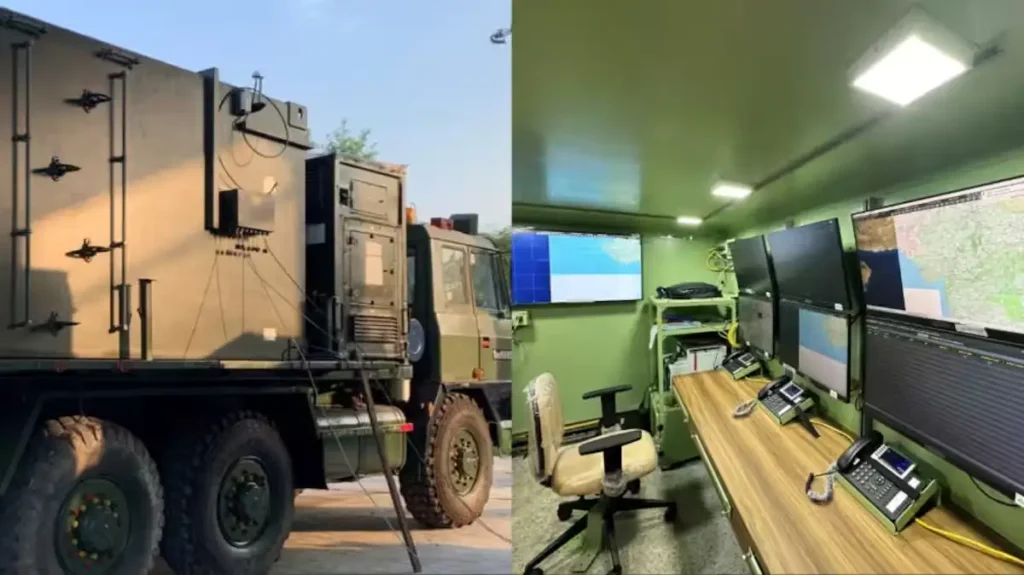Akashteer: The AI-Driven Defence System That Shielded India from Drone and Missile Threats
India recently showcased a major leap in defense technology during a tense moment with Pakistan. On the night of May 8–9, Pakistani forces launched a wave of drones and missile threats across the border. However, India responded swiftly and decisively, thanks to its newly deployed AI-powered air defense system — Akashteer.

This rapid and successful interception of aerial threats marks a turning point in India’s military capabilities. It also highlights the growing importance of artificial intelligence in modern warfare. Let’s explore how Akashteer works, what sets it apart, and why it played such a crucial role in safeguarding Indian airspace.
What Exactly Is Akashteer?
Akashteer is a next-generation Air Defence Control and Reporting System developed by Bharat Electronics Limited (BEL). It was built specifically for the Indian Army to monitor, track, and neutralize aerial threats using real-time data and artificial intelligence.
Unlike traditional systems that rely heavily on human intervention, Akashteer integrates multiple ground-based radars, surveillance assets, and weapon systems into a single, centralized control network. This seamless coordination allows the army to react within seconds — a critical advantage in modern-day conflicts.
Furthermore, the system uses AI to analyze large amounts of data, distinguish between friendly and hostile targets, and suggest the most effective counteraction. As a result, it significantly reduces the chances of human error during high-pressure situations.
How India Foiled the May 8–9 Attack
On the intervening night of May 8–9, Pakistani forces attempted to breach Indian airspace using a combination of drones and missiles. These threats appeared to target strategic installations and were likely meant to provoke or destabilize.
India’s defense units, supported by Akashteer, immediately detected the incoming threats. The system analyzed their trajectory, altitude, and speed within seconds. Consequently, ground teams were alerted and guided to intercept them using anti-aircraft missiles and electronic countermeasures.
Because of this rapid and automated coordination, India successfully neutralized all threats before they could cause any damage. The country did not suffer any casualties or infrastructure loss, and life returned to normal quickly.
What Makes Akashteer So Effective?
Akashteer’s effectiveness comes from its ability to fuse intelligence, automation, and real-time decision-making. In an age where drones and precision missiles can strike in minutes, India needed a system that could act faster than human operators. Akashteer does exactly that.
Here are several reasons why this system is a game-changer:
- AI-Driven Threat Recognition: Akashteer quickly evaluates whether an aerial object is hostile or friendly. It uses machine learning algorithms to improve its accuracy over time.
- Networked Response System: All components — from radar stations to missile launchers — are linked. Therefore, the entire network can respond as a single, synchronized unit.
- Flexible Deployment: The system isn’t limited to fixed installations. It can move with army formations, offering real-time protection during dynamic field operations.
- Multiple Target Handling: Akashteer can track and engage several threats simultaneously, which is especially useful during swarm drone attacks or multi-vector strikes.
Boosting India’s Self-Reliance in Defense
Beyond its operational success, Akashteer also symbolizes India’s commitment to self-reliance. Developed entirely within the country, the system reflects the capabilities of India’s defense manufacturing sector and aligns with the Atmanirbhar Bharat (Self-Reliant India) initiative.
By creating such systems domestically, India reduces its dependency on foreign military technology. More importantly, local development ensures that systems are tailored to Indian terrain, threat profiles, and combat scenarios.
The Indian Army worked closely with BEL to design Akashteer according to battlefield needs. This collaboration between military and industry has paved the way for more indigenous innovation in the defense space.
Implications for Regional Security
The successful defense against Pakistan’s recent attempt demonstrates more than just technological competence — it signals deterrence. When hostile neighbors understand that their weapons can be neutralized even before impact, they may think twice before launching another attack.
Furthermore, Akashteer is not limited to responding to large-scale invasions. It also excels in defending against covert drone operations, cross-border reconnaissance flights, and missile probes. These types of threats are increasingly common, making real-time airspace monitoring essential.
As India continues to modernize its military, Akashteer stands out as a blueprint for future defense strategies. Its performance under real conflict conditions has proven that AI-based systems can dramatically improve national security.
A Step Toward Smart Warfare
The deployment of Akashteer reflects a broader shift within the Indian armed forces toward smart warfare. Military planners now recognize that speed, information, and automation are just as critical as weapons and manpower.
New threats emerge rapidly in today’s battlefield — whether it’s a swarm of drones, a hypersonic missile, or a cyberattack. Therefore, having a system that can automatically respond, adapt, and learn becomes not just beneficial, but essential.
Akashteer represents this evolution. It’s not just a tool; it’s a digital brain that allows India to stay ahead of fast-evolving threats.
Final Thoughts
India’s ability to repel the May 8–9 aerial threats without a single casualty is a clear testament to its growing technological prowess. At the heart of this success was Akashteer — a powerful blend of AI, automation, and indigenous innovation.
The system did not just detect threats; it orchestrated a full response, coordinating units across land and air in real time. By doing so, it kept Indian citizens safe and protected critical infrastructure from potential devastation.
As the nature of warfare continues to evolve, India has shown it is ready — not just with weapons, but with intelligence. Akashteer is proof that the future of national security lies in smart, homegrown defense solutions that can respond faster and more effectively than ever before.






